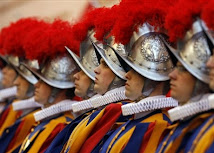First, though, I must address where this secret knowledge is hidden, far from sight of young adults and catechists alike. For surely, it must be scrawled on a fragile parchment in ancient runes decipherable only by a few very wise souls. It must be, for no other reason could keep it from being the very foundation and source of any pre-confirmation catechesis. Perhaps it was divided into thirds and entrusted to three different religious orders to keep the knowledge out of the hands of the laity. But alas, the Church's genuine theology of confirmation is not kept under lock and key in the archives of a desert monastery, but instead hidden in plain sight in the Catechism of the Catholic Church. Which begs the question, to what extent are confirmation classes using the Catechism to guide the formation of the confirmandi?
Turning to the source, we see that confirmation is in fact the sealing of a baptized Christian with the gift of the Holy Spirit. This conferring of the holy spirit by a minister of Apostolic authority goes back to the Acts of the Apostles (19:2). When we look at what is meant by a seal, it was a sign of authenticity, providing assurance that a document was not a forgery or fake. The seal would be affixed to a document and carry much the same weight that a signature does on our legal forms today. It is this meaning of seal that the Church employs in imparting the seal of the Holy Spirit. It is a mark by which the Spirit working through the Bishop marks the confirmandi as authentically or genuinely baptized. This post-baptismal anointing is known as Chrismation.
As mentioned before, the Eastern Churches have kept chrismation as part of the baptismal rite itself, thus preserving the unity of the sacraments of initiation. Orthodox priests thus perform Chrismation almost immediately following baptism, using the myron or chrism that was consecrated by the bishop. In the Western Church, however, the bishop alone is the ordinary minister of the sacrament. With the rise of infant baptism it became not only impractical but logistically impossible for the bishop to be present at the baptism of every sheep in his fold. The administration of baptism was delegated to priests and deacons, while the bishop reserved to himself the conferral of Chrismation. This meant that these two sacraments of initiation were separated until such time as the baptized could travel to the cathedral or the bishop should make a pastoral visit to their parish. As dioceses grew so did the span of time between one's baptism and chrismation. Ultimately the age of reason was established as the appropriate benchmark for the reception of the sacrament, the same as for Reconciliation and first Holy Communion.
At what point the age of reason was determined to be an appropriate span of time I do not know, and will investigate further at another time. Whatever the circumstances surrounding that decision, it was never the mind of the Church that confirmation be some sort of rite of passage into adulthood.
Priests, Catechists, even Bishops would do well to emphasize this notion of sealing of one's baptism, conferral of the Holy Spirit and its effects on the recipient, and begin to phase out this misguided but popular concept of choosing one's faith as an adult.





No comments:
Post a Comment